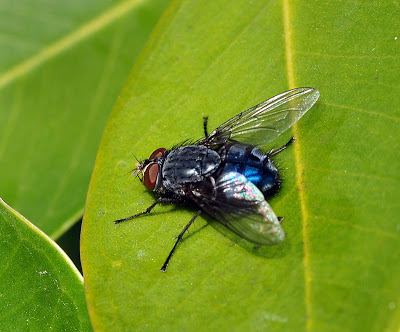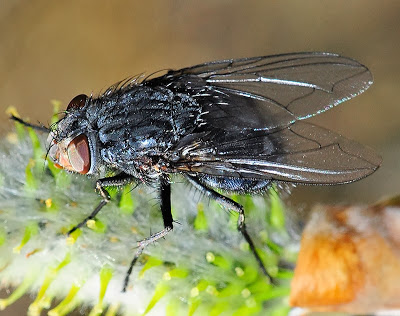Adaption
Size:
The blowfly C. vicina is a fairly large Dipteran species and
generally measure at 5-13 millimeters in length. The
conspicuous size range is a function of the adaption to fighting
for food. Since fresh cadavers are limited and furthermore
last only a short time, there is huge competition between
individuals. The size of adults has a big impact on their
life spans and fecundity (Natural History Museum Online 2013).

Sense of Smell:
According to (Aak & Knudsen 2012) saprophagous (decomposing) blowflies, which
include C. vicina, have the ability to detect olfactory cues
indicating the beginning stages of decomposition. Since
they are primary colonizers of cadavers (Davies & Harvey 2012)
this adaption is essential. In fact, these organisms’
senses are so in tune that they can arrive at the scene of a
cadaver within minutes of death (Davies & Harvey 2012). Their
olfactory cues give them a huge advantage over other, slower
decompers. Fungi like Aleuria aurantia (http://bioweb.uwlax.edu/bio203/2010/feagles_ange/)
require more time to access cadavers' nutrients. Their
rapid arrival is also a great tool in forensic entomology
because it allows us to
discover the time of death of individuals (Aak & Knudsen 2012) which will be
discussed more in depth on the
Role in Forensics page.

Flight:
Being animals these organisms possess forms of locomotion, and
can travel by means of legs and wings (Campbell et al. 2008).
Having wings is important adaption considering the fact that they
have to find scarce carcasses to feed on. As all members of
Diptera, the hind wings of these organisms are minimized to little
“club-like” structures known as halters. These halters are
used as stabilizers for when in flight. Halters are essential
for these flies because they give them their ability to manuver efficiently and hover in specific
locations (CSIRO 2013). To understand a different
variation of wings in insects, check out Mayflies at
http://bioweb.uwlax.edu/bio203/2010/kalmuck_tyle/.
Injestion/Digestion:
In the majority of Diptera species, and in this case C. vicina,
digestion is partially external because salivary secretions are used
to make potential food a liquid so then it can be easily sucked up.
The secretions are crucial because they allow them to injest colder
bodies and/or tough matter. Adult flies are then able to
ingest their food through sucking and/or piercing organs on their
mouths, which is fast and simple. This is most likely an
adaption to competition from extreme cadaver frenzys (CSIRO 2013).
Find out how this species Reproduces!